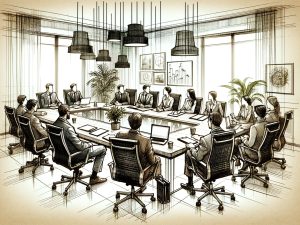 Can you imagine being in a high-stakes meeting with the executive leadership of your company. The decisions made in that room ultimately shape the future of the organisation, and your ability to contribute effectively could make or break your career trajectory. Are you equipped with the right skills to navigate the C-Suite?
Can you imagine being in a high-stakes meeting with the executive leadership of your company. The decisions made in that room ultimately shape the future of the organisation, and your ability to contribute effectively could make or break your career trajectory. Are you equipped with the right skills to navigate the C-Suite?
What separates professionals who excel in these high-level environments from those who falter? It’s not just about knowledge; it’s about mastering a set of nuanced skills that allow you to communicate, influence, and align with the visionaries at the top. If you’re aiming to work closely with the C-Suite, these are the competencies that will set you apart.
Working with the C-Suite isn’t just about reporting numbers or sharing project updates. Executives expect a level of sophistication in communication and strategic thinking that aligns with the organisation’s broader goals. Yet, many professionals struggle with understanding how to operate in these high-pressure environments, often leading to missed opportunities or misunderstandings that can stall their career advancement.
The pain point for many is clear: How do you speak the language of the C-Suite while ensuring your contributions are seen as invaluable?
Essential Skills for C-Suite Collaboration:
- Strategic Thinking
The C-Suite focuses on the big picture. To be a valuable partner, you need to demonstrate that you’re not just solving today’s problems but thinking about tomorrow’s challenges. Understand the company’s strategic objectives, and frame your suggestions and insights in a way that aligns with those goals. - Executive Communication
The ability to communicate clearly, concisely, and confidently is crucial when dealing with senior leaders. You must distil complex ideas into digestible insights, avoiding jargon and unnecessary details. Learn to present data and recommendations in a way that resonates with the executive agenda. - Emotional Intelligence (EQ)
Working with senior leaders requires a high degree of emotional intelligence. The ability to read the room, sense unspoken concerns, and adapt your approach based on the emotional climate can help you navigate challenging conversations and build trust with key decision-makers. - Influence Without Authority
Often, when working with executives, you may not have direct authority. Your ability to influence decisions and actions through persuasion and well-grounded arguments, rather than hierarchical power, is a skill that sets apart those who can drive change from those who merely follow orders. - Business Acumen
Understanding how the business works, from financials to market positioning, is essential. Executives are focused on the return on investment (ROI) of every initiative. Demonstrating your understanding of the broader business context, and how your work impacts profitability or growth, will position you as a key player. - Adaptability and Agility
The C-Suite operates in a world of rapid change, where decisions must be made quickly, and strategies shift often. The ability to adapt your approach, remain flexible, and adjust your tactics in real-time will show that you can operate in a fast-paced, dynamic environment. - Conflict Resolution
Disagreements are inevitable in high-stakes environments. Your ability to mediate conflicts, offer solutions that consider various viewpoints, and move the conversation forward constructively can make you indispensable when tensions arise at the executive level.
Success in working with the C-Suite doesn’t solely depend on your technical skills or job expertise, it hinges on your ability to think strategically, communicate effectively, and influence outcomes in a way that aligns with the company’s vision. By mastering these essential skills, you position yourself not just as a contributor but as a trusted advisor.





